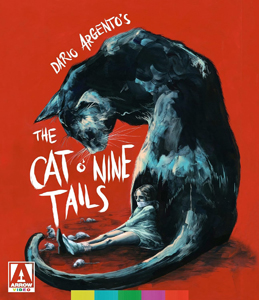After the twist ending in his directorial debut, “The Bird with the Crystal Plumage” (1970), Dario Argento’s follow-up “The Cat o’ Nine Tails” (1971) was likely a comparative disappointment at the time, similar to how M. Night Shyamalan’s non-twist films land with a thud today.
“Cat” is not too bad of a mystery, it’s armed with likeable characters, and it continues to showcase Argento’s suspenseful and violent kills. But in the end, it’s understandable that it’s not as popular as his debut.
In Rome (but with everyone speaking English for our convenience), reporter Carlo (“Beneath the Planet of the Apes’ ” James Franciscus) and blind ex-reporter Franco (Karl Malden) investigate a string of killings that seem connected. Cutely, Franco’s young niece, Lori (Cinzia De Carolis), is his helper.

“The Cat o’ Nine Tails” (1971)
Director: Dario Argento
Writers: Dario Argento (screenplay, story); Bryan Edgar Wallace (screenplay); Luigi Cozzi, Dardano Sacchetti (story)
Stars: James Franciscus, Karl Malden, Catherine Spaak
Grasping at strands
Carlo and Franco can’t grasp a strand to get them started, although they joke that there are at least nine of them – it’s like that ancient whip, a cat o’ nine tails. (Ironically, considering the title and Argento’s love of cat symbolism, the animal itself plays no role.)
So we stick with “Bird’s” themes of non-official investigators and slasher kills, but the mix is less successful. When I reflect on the clueing of the mystery – penned by Argento and three collaborators – it holds up well, but I didn’t get swept up in it while watching.
The murders are committed with the goal of quashing the details of a break-in at a genetics laboratory. The lab is studying people with the XYY chromosome and has found they have high aggression; prison populations have an inordinate percentage of XYY inmates.
(SPOILERS FOLLOW.)
The clues will reward eagle-eye viewers and sharp-eared listeners. Kicking off the plot, Franco overhears someone saying he’s not looking to blackmail the other person, but he must report what he knows. Combined with our later knowledge that a report on internal company testing for the XYY chromosome was handled in the break-in, we might assume that report – rather than a report to the police — is the motive.
Interestingly, the scientists’ dialog doesn’t indicate what most modern viewers probably know: XYYs are all males; therefore a female can’t be a suspect. But Carlo later does suspect his sexpot lover, Anna (the striking Catherine Spaak) – the daughter of the genetics company’s owner – because of some bizarre coincidences. In the end, the killer is an employee we barely met earlier. Quite a comedown from the more intimate impact of “Bird.”
(END OF SPOILERS.)

Mystery resolved, but themes could’ve been sharper
So the mystery is well-clued upon reflection, but “Cat” engages with other things, namely set pieces. The most impressive is when the wife of a scientist has figured out who the killer is and she hears sounds in her bathroom. She closes the window, figuring it was just the breeze. But we see the shower curtain rustle. That’s a nice little chill, and Argento also sneaks a hand into the side of the screen in a scene where Carlo and a break-in expert are skulking around what they think is an empty house.
“Cat” exemplifies an issue that many slasher films have had to juggle: The showiness of the kills can distract from the mystery. That’s part of what happens here, but giallo kills are more spread out than golden-era slasher kills, so I think the mystery could’ve been emphasized in more robust fashion.
As always with Argento, though, the film is worth watching for style alone. The killer’s method of strangling with piano wire must’ve been shocking at the time; today, the victims’ struggles seem over-acted. Some neat camera trickery holds up, though. In a scene where the little girl is slapped, the camera is directly on her, the actress mimics being slapped, and the sound effect sells the cheap, safe workaround.
Known as the Italian Hitchcock, Argento gives us a rooftop pursuit that’s like the cat-burglar film “To Catch a Thief” times 10. I’d be very surprised if his close-up on two glasses of milk is not a nod to “Suspicion.” He’s emphasizing that the milk might be poisoned by referencing another movie where milk might be poisoned.
In the end, the mystery is solved, but dangling filmic threads aren’t totally achieved. The irony of the killer’s motive doesn’t zing, and more could’ve been done with Franco’s other four senses as keys to solving the case. Even if “Cat o’ Nine Tails’ ” uses all nine lives in the arena of reappraisal, it won’t rank among Argento’s elite, but it is worth a watch (and a listen).

